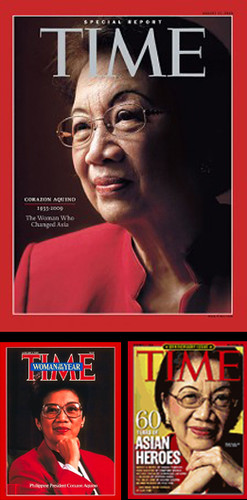
'The Woman Who Changed Asia.' Former Philippine President Corazon Aquino graces the cover of Time Magazine again. The publication named her as Woman of the Year in 1986 (left) and one of its 60 Asian Heroes in 2006 (right). Images from TIME.com It was a fitting capstone for the person it hailed as its Woman of the Year in 1986 and listed as one of its Asian heroes when it celebrated its sixth decade in 2006. Renowned international publication Time Magazine has once again paid tribute to and celebrated the life of former President Corazon Aquino, who it named as “the woman who changed Asia." Mrs. Aquino passed away last August 1, 2009 after a long battle with colon cancer. Her death has gripped the whole Philippine nation and stunned the world, as seen in the outpouring of mourning and sympathy following her demise. Time Magazine’s August 17, 2009 Asian edition devoted three special reports chronicling Mrs. Aquino’s ascent to power, how she ran the Philippine government as “a miracle worker," and how people-backed, nonviolent protests across the world drew inspiration from the historic 1986 EDSA Revolution. The tribute begins with Hannah Beech’s article calling Mrs. Aquino as “The Saint of Democracy." “The only weapon (Mrs. Aquino) possessed was moral courage. But with it she discovered a groundbreaking truth: that a populace holding nothing more than candles and rosary beads could face a cavalcade of tanks, topple a dictator, and most improbable of all, usher in democracy," it said. The article described the Philippine’s first People Power Revolt as the catalyst of peaceful uprisings against authoritarian regimes in Asia, Latin America, Eastern Europe, and the Soviet Union. It even quoted South Africa’s former Archbishop Desmond Tutu as saying: “When we were struggling with apartheid, we spoke of People Power. You had to be with the people to make things happen." The magazine also republished “I am Not Going to Surrender," which first appeared in Time’s March 10, 1986 issue, a few days after the late strongman Ferdinand Marcos’ 20-year dictatorship was toppled. The article recounts the dramatic sequence of events from February 22 to 25 of that year that started with the defection of then Defense chief Juan Ponce Enrile and Armed Forces Vice Chief of Staff Fidel V. Ramos and concluded with the unceremonious expulsion of dictator Marcos.
’Divine Inspiration’ Howard Chua-Eoan’s piece titled “A Miracle Worker in a Plain Yellow Dress" details how the 1983 assassination of Mrs. Aquino’s husband, Ninoy, fuelled sentiments against the Marcos regime and thrust the soft-spoken widow as an opposition symbol. “The devout and stoic Roman Catholic widow became the incarnation of a pious nation that had itself suffered silently through more than a decade of autocratic rule," it said. Even as her six-year rule was besieged by military coup attempts, the woman in yellow, armed with her faith, had restored the democratic processes and institutions that were left in shambles by her predecessor. This, despite her late husband’s prediction that anyone who would succeed Ferdinand Marcos would wear out after six months in office “like horse manure."
Icon of Democracy It is not the first time that Mrs. Aquino had graced Time Magazine’s cover. In 1986, she was named Woman of the Year, the first female to receive Time’s annual distinction after Queen Elizabeth II in 1952. She was also recognized in 2006 as among the 60 Asian Heroes, along with Mother Teresa, the Dalai Lama, Mohandas Gandhi, and fellow democracy icon, Myanmar’s Aung San Suu Kyi. Three other Filipinos made it to the list. They are: billiards champion Efren “Bata" Reyes and Philippine Daily Inquirer founders Eugenia Apostol and Letty Jimenez-Magsanoc. Time also featured Mrs. Aquino for three times in February and March 1986, in the wake of the historic People Power revolution that catapulted her to the world’s spotlight.
- GMANews.TV 




